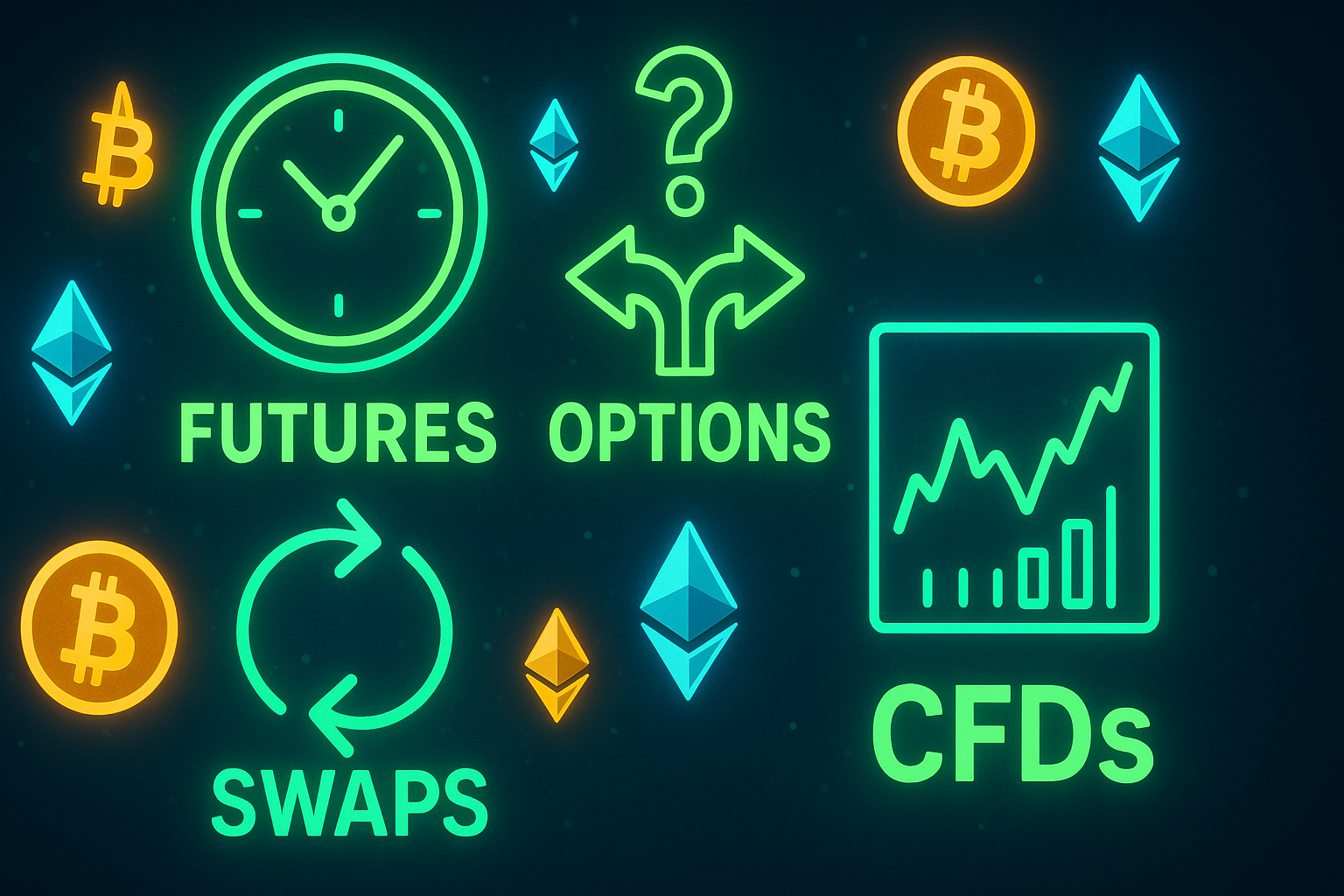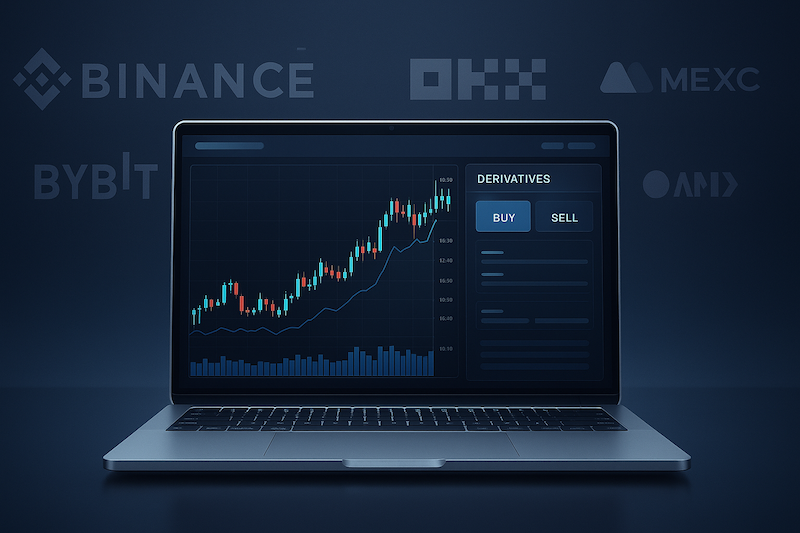 The cryptocurrency market is constantly evolving, offering traders and investors new tools to generate profits. One of the most popular and powerful tools is crypto derivatives—financial contracts tied to the price of digital assets. These instruments allow users to profit from price fluctuations without directly owning the underlying cryptocurrencies and to hedge their investments against market risks. In this article, we’ll explore what crypto derivatives are, how they work, their types, advantages, risks, and where to trade them.
The cryptocurrency market is constantly evolving, offering traders and investors new tools to generate profits. One of the most popular and powerful tools is crypto derivatives—financial contracts tied to the price of digital assets. These instruments allow users to profit from price fluctuations without directly owning the underlying cryptocurrencies and to hedge their investments against market risks. In this article, we’ll explore what crypto derivatives are, how they work, their types, advantages, risks, and where to trade them.
Table of Contents
- What Are Crypto Derivatives?
- How Do Crypto Derivatives Work?
- Why Use Crypto Derivatives?
- Types of Crypto Derivatives (Futures, Options, Swaps, Contracts for Difference - CFDs)
- Advantages and Risks of Crypto Derivatives
- Where to Trade Crypto Derivatives
- Conclusion
What Are Crypto Derivatives?
Crypto derivatives are financial instruments whose value depends on the price of an underlying asset, such as Bitcoin (BTC), Ethereum (ETH), or other cryptocurrencies. Essentially, they are contracts between two parties agreeing to trade an asset in the future at a predetermined price. The key advantage of derivatives is that traders don’t need to own the cryptocurrency to profit from its price movements.
Crypto derivatives originated in traditional financial markets, where similar instruments are used to trade stocks, commodities, and currencies. Today, they account for a significant portion of the crypto market. As of July 2025, open interest (the total value of outstanding positions) in perpetual futures stands at $791.3 billion, while traditional futures have an open interest of $2.68 billion, highlighting their immense popularity among traders.
How Do Crypto Derivatives Work?
Crypto derivatives are agreements between a buyer and a seller to lock in the price and terms of a cryptocurrency transaction at a specific point in the future. The underlying asset (e.g., BTC) may not be owned by either party—the contract only involves the obligation or right to buy/sell the asset at a pre-agreed price.
A simple analogy: imagine ordering a smartphone online at a fixed price for delivery in three months. If the market price of the smartphone rises by then, you save money by paying less. If the price drops, the seller benefits. Crypto derivatives function similarly: if the asset’s price rises by the contract’s execution date, the buyer profits; if it falls, the seller gains.
Key Features of Crypto Derivatives:
- Expiration: Most derivatives have an expiration date, after which the contract is either executed or expires.
- Margin: Traders deposit collateral (margin) to secure their obligations. If the market moves against their position and the margin is insufficient, the position may be liquidated by the exchange.
- Leverage: Derivatives allow the use of borrowed funds, amplifying potential profits (and losses). For example, with 10x leverage, a 5% price increase yields a 50% profit on your capital.
Why Use Crypto Derivatives?
Crypto derivatives serve several purposes for traders and investors:
- Risk Hedging: Derivatives help protect capital from sharp price swings. For instance, a Bitcoin miner can sell a futures contract to lock in the sale price of future coins. If the market drops, the miner still receives the agreed-upon amount.
- Speculation: Traders use derivatives to profit from price movements, including downward trends. By opening a short position, they can sell an asset and buy it back cheaper if the price falls, making derivatives a versatile trading tool.
- Leverage: Trading with leverage allows control of large positions with minimal capital, attracting day traders seeking high returns. However, leverage also magnifies losses, potentially exceeding the initial investment.
Types of Crypto Derivatives
Crypto derivatives come in several forms, each with unique features and use cases. Let’s explore the main types.

Futures
A futures contract is a standardized agreement to buy or sell a cryptocurrency at a set date and price. Futures are traded on exchanges and used for both speculation and hedging.
Example: You buy a Bitcoin futures contract at $60,000 with execution in one month. If BTC’s price rises to $65,000, you earn $5,000 per contract. If it drops to $55,000, you lose $5,000.
Perpetual Futures: A subtype of futures with no expiration date, allowing positions to be held indefinitely. To balance spot and futures prices, exchanges charge a funding fee every 8 hours. Perpetual futures dominate the market, with open interest growing by $175 billion in July 2025 alone.
Forwards: Similar to futures but traded over-the-counter (OTC) directly between parties. They are less standardized and carry higher counterparty risk.
Options
An option grants the right (but not the obligation) to buy (call option) or sell (put option) an asset at a fixed price before a specific date. The buyer pays a premium for this right, and losses are limited to that premium.
Example: You buy a call option on ETH at $4,000 with a $200 premium. If ETH rises to $4,500 in a month, you exercise the option and earn $300 ($500 minus the premium). If the price falls, you let the option expire, losing only the $200 premium.
Options are popular for hedging and complex trading strategies due to their risk-limiting nature.
Swaps
A swap is a contract combining two transactions: buying/selling an asset now and executing the reverse trade in the future. Crypto swaps are often used to exchange payment flows or lock in prices.
Example: A trader buys BTC today and agrees to sell it in a year at a fixed price, securing profit or hedging against price changes.
Swaps are more complex than futures or options and are typically used by institutional investors.
Contracts for Difference (CFDs)
A CFD is an agreement to exchange the difference between an asset’s price at the contract’s opening and closing. The asset itself is not purchased.
Example: You open a CFD betting on BTC’s price rising from $60,000. If it climbs to $62,000, you earn $2,000. If it falls to $58,000, you pay $2,000.
CFDs are popular among speculators for their simplicity and leverage options.
Advantages and Risks of Crypto Derivatives
Crypto derivatives offer significant opportunities but come with high risks. Let’s examine their pros and cons.
Advantages
- Flexibility: Derivatives allow profits from both rising and falling markets. Short positions, unavailable in spot trading, enable selling assets without owning them.
- Hedging: Investors and businesses use derivatives to protect portfolios from volatility. For example, options or futures can lock in asset prices, minimizing losses during market crashes.
- Leverage: Leverage enables control of large positions with small capital, boosting returns. High liquidity and low fees in derivative markets attract professional traders.
Risks
- High Volatility: Cryptocurrencies are inherently volatile, and leverage amplifies this effect. A wrong prediction or sudden market move can wipe out your deposit.
- Complexity: Derivatives require a deep understanding of markets, margin, liquidation, and other mechanics. Beginners often make costly mistakes due to inexperience.
- Additional Costs: Trading derivatives involves fees (e.g., funding fees for perpetual futures) and interest on leverage. Holding positions long-term can become expensive.
- Platform Risks: If an exchange goes bankrupt or faces technical issues, traders may lose funds. The collapse of FTX in 2022, which left clients without deposits, is a prime example.
Where to Trade Crypto Derivatives

Choose reputable exchanges with high liquidity and a strong track record for trading crypto derivatives. Here are some popular platforms:
- Binance — The largest crypto exchange, offering a wide range of futures, options, and perpetual contracts. Suitable for both beginners and professionals.
- Bybit — Popular for its user-friendly interface and low fees, ideal for trading perpetual futures.
- OKX — Provides diverse derivatives, including futures, options, and swaps, with robust security.
- MEXC — A fast-growing exchange with competitive conditions and support for new cryptocurrencies.
Before trading, research the platform’s trading conditions, fees, and reviews. Start with a demo account to test strategies without risk.
Useful Resources:
- 3 ways to earn risk-free profits from crypto futures
- Cryptocurrency Futures in 2025: A Complete Guide for Beginners
- The best discounts and cashbacks for trading on spot and futures
- A detailed guide to futures trading for beginners
- OKX.com referral code CRYPTOAGE for 20% discount on spot and futures trading fees
- The most profitable referral ID (code) for registration on the Binance exchange for spot and futures trading
- Choosing a cryptocurrency exchange for trading bitcoin futures
Conclusion

Crypto derivatives are a powerful tool, unlocking new opportunities for profit and risk management in the volatile cryptocurrency market. They are suitable for both speculative trading and protecting investments. However, their complexity and high risks demand preparation and caution.
Beginners should start by learning the basics, practicing on the spot market, and making small trades without leverage. Experienced traders can use derivatives for advanced strategies. Always manage risks and choose reliable platforms like Binance, Bybit, OKX.
Ready to try crypto derivatives trading? Register on a trusted exchange and begin your journey to success!









